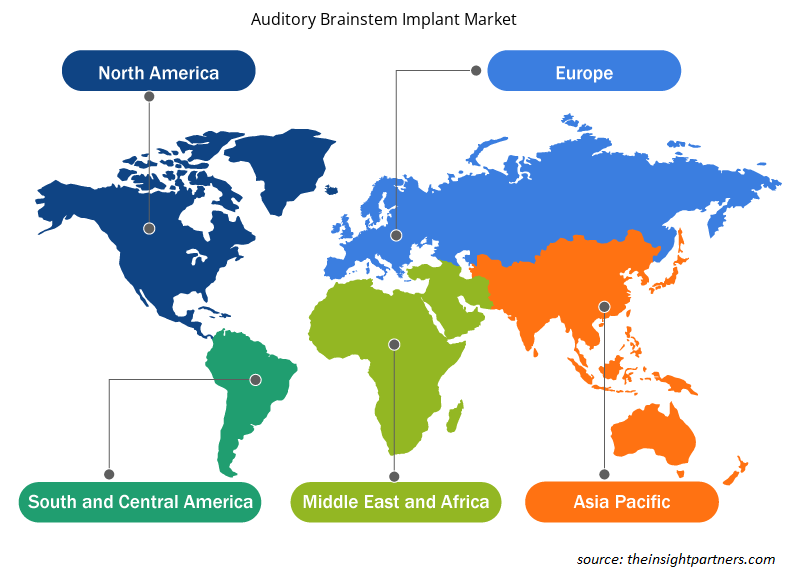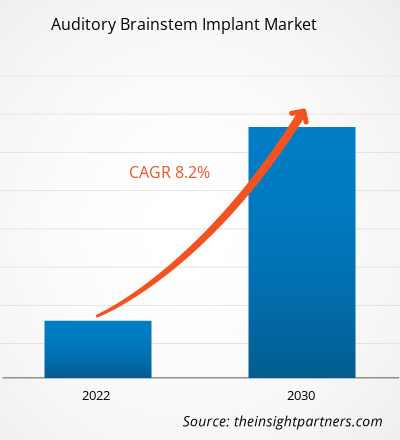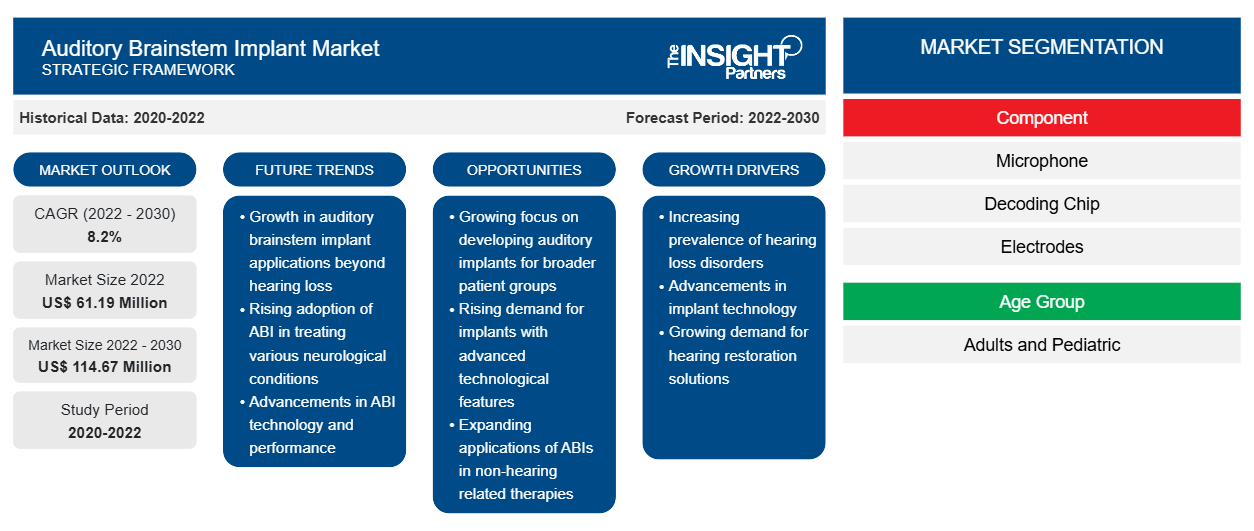[Rapport de recherche] Le marché des implants auditifs du tronc cérébral devrait passer de 61,19 millions USD en 2022 à 114,67 millions USD d'ici 2030 ; il devrait enregistrer un TCAC de 8,2 % de 2022 à 2030.
Point de vue de l'analyste
L'implant auditif du tronc cérébral (ABI) est un dispositif qui aide les patientssouffrant de troubles auditifs et ne pouvant bénéficier d’un implant cochléaire (IC) en raison de contraintes anatomiques. Ce dispositif neuroprothétique contourne le nerf cochléaire et stimule électriquement les neurones de second ordre du noyau cochléaire (NC) à l’aide d’un réseau de surface multicanal. Il est généralement recommandé aux patients présentant des pathologies cochléaires et rétrocochléaires.
L' analyse du marché des implants auditifs du tronc cérébral explique les moteurs de croissance tels queprévalence croissante de la perte auditive neurosensorielle et avancées technologiques dans les dispositifs ABI. Cependant, les coûts élevés des traitements chirurgicaux et les politiques de remboursement limitées freinent la croissance du marché. En outre, le développement de dispositifs hybrides devrait émerger comme les tendances futures du marché des implants auditifs du tronc cérébral au cours de la période 2022-2030.
Informations sur le marché
La prévalence croissante de la perte auditive neurosensorielle devrait stimuler la croissance du marché des implants auditifs du tronc cérébral
Selon un article publié par StatPearls en 2023, les États-Unis signalent chaque année entre 5 et 27 cas de perte auditive neurosensorielle soudaine (SNHL) pour 100 000 personnes, ce qui se traduit par environ 66 000 nouveaux cas par an. En outre, environ 16 % des adultes dans le monde souffrant d’une perte auditive invalidante souffrent d’une perte auditive induite par le bruit (NIHL), une autre cause importante de perte auditive chez les adultes liée au bruit professionnel. Il s’agit toujours d’une maladie professionnelle courante malgré la législation en vigueur dans la plupart des pays développés pour prévenir la NIHL. De nombreuses études ont montré que les ICA réussissent à restaurer l’audition des patients atteints de neurofibromatose de type 2 (NF2) atteints de surdité bilatérale. Dans un article publié par Wolters Kluwer en février 2021, une étude a été menée pour évaluer l’implantation auditive du tronc cérébral dans le cas d’un homme de 65 ans diagnostiqué avec une otospongiose cochléaire bilatérale et une perte auditive neurosensorielle profonde. L'étude a conclu qu'une otospongiose étendue de la cochlée peut entraîner un mauvais résultat de l'implantation cochléaire. Dans de tels cas, un implant auditif du tronc cérébral (ABI) pourrait être envisagé comme traitement alternatif pour la perte auditive neurosensorielle profonde chez les enfants et les adultes sourds qui ne bénéficient que de peu ou pas des aides auditives et ne sont pas des candidats appropriés pour les implants cochléaires.
En outre, la disponibilité d’implants auditifs avancés équipés de technologies innovantes a amélioré leur efficacité dans le traitement des déficiences auditives. Ceci, combiné à des approches chirurgicales mini-invasives, a joué un rôle important dans la croissance et l’importance du marché des implants auditifs du tronc cérébral.
Tendance future
Le développement de dispositifs hybrides devrait émerger comme tendance future sur le marché des implants auditifs du tronc cérébral au cours de la période de prévision
Le développement de dispositifs hybrides combinant implants cochléaires et du tronc cérébral vise à offrir de meilleurs résultats auditifs aux patients souffrant de perte auditive et qui ne sont pas éligibles à l'implantation cochléaire en raison d'anomalies de la cochlée et du nerf cochléaire. Selon un article publié par l'International Journal of Audiology en octobre 2022, une étude visant à évaluer le développement de l'impédance après l'implantation d'électrodes Hybrid-L a été réalisée. Dans le cadre de cette étude, 137 patients adultes ont été implantés avec une électrode Hybrid-L et ont été suivis pendant au moins un an. L'étude a suggéré une croissance tissulaire réduite avec le réseau d'électrodes Hybrid-L malgré des contacts plus petits.
Par conséquent, le développement d’implants hybrides visant à réduire les risques chirurgicaux, les complications et le temps de récupération des patients devrait stimuler la croissance du marché des implants auditifs du tronc cérébral au cours de la période 2022-2030.
Personnalisez ce rapport en fonction de vos besoins
Vous bénéficierez d'une personnalisation gratuite de n'importe quel rapport, y compris de certaines parties de ce rapport, d'une analyse au niveau des pays, d'un pack de données Excel, ainsi que de superbes offres et réductions pour les start-ups et les universités.
- Obtenez les principales tendances clés du marché de ce rapport.Cet échantillon GRATUIT comprendra une analyse de données, allant des tendances du marché aux estimations et prévisions.
Segmentation et portée du rapport
Le marché des implants auditifs du tronc cérébral est segmenté en fonction du composant, de la tranche d’âge, de l’application et de l’utilisateur final.En fonction des composants, le marché des implants auditifs du tronc cérébral est segmenté en microphone, puce de décodage et électrodes.
En fonction de la tranche d'âge, le marché des implants auditifs du tronc cérébral est divisé en adultes et enfants. En fonction de l'application, le marché est divisé en perte auditive neurosensorielle et perte auditive de transmission. En termes d'utilisateur final, le marché des implants auditifs du tronc cérébral est classé en hôpitaux, cliniques ORL et centres de chirurgie ambulatoire.
Analyse segmentaire :
Informations basées sur les composants
Le marché des implants auditifs du tronc cérébral, par composant, est segmenté en microphone, puce de décodage et électrodes.Le segment des électrodes détenait la part de marché la plus élevée en 2022.
Informations basées sur les groupes d'âge
Le marché des implants auditifs du tronc cérébral, par groupe d’âge, est segmenté en adultes et en pédiatrie.Le segment des adultes détenait une part de marché plus importante en 2022 et devrait détenir la plus grande part des revenus du marché mondial au cours de la période 2022-2030. Cela est dû à l'incidence croissante de la perte auditive profonde congénitale avec anomalies dans la population adulte du monde entier, ce qui entraîne une augmentation des interventions chirurgicales d'implantation du tronc cérébral auditif. Les patients souffrant de perte auditive neurosensorielle sévère (SNHL) qui ne sont pas éligibles à une chirurgie du nerf auditif ou qui présentent des cicatrices de l'oreille interne causées par un traumatisme ou une infection ont trouvé que la chirurgie d'implantation du tronc cérébral auditif était extrêmement efficace.
Informations basées sur les applications
Le marché, par application, est divisé en perte auditive neurosensorielle et perte auditive conductive.Le segment de la perte auditive neurosensorielle détenait la plus grande part de marché en 2022.
Informations basées sur l'utilisateur final
Le marché des implants auditifs du tronc cérébral, en fonction de l’utilisateur final, est classé en hôpitaux, cliniques ORL et centres de chirurgie ambulatoire. Le segment des hôpitaux connaîtra le TCAC le plus élevé du marché entre 2022 et 2030. Les implants auditifs du tronc cérébral impliquent des interventions chirurgicales complexes qui nécessitent une attention médicale spécialisée, notamment un diagnostic, un traitement et une surveillance continue. Les hôpitaux jouent un rôle essentiel dans la prestation de services de santé complets aux patients.
Analyse régionale
Le marché des implants auditifs du tronc cérébral, en fonction de la géographie, est segmenté en cinq grandes régions : l'Amérique du Nord, l'Europe, l'Asie-Pacifique, le Moyen-Orient et l'Afrique, et l'Amérique du Sud et l'Amérique centrale. Le marché en Amérique du Nord devrait croître à un rythme significatif au cours de la période 2022-2030En raison de facteurs tels que la grande disponibilité et l'adoption d'options de traitement avancées et la concentration de fabricants clés dans la région. Les États-Unis, en particulier, enregistrent un taux d'adoption élevé d'implants auditifs du tronc cérébral en raison de divers facteurs tels que l'incidence croissante de la perte auditive et la sensibilisation croissante à ces implants.
Cochlear Limited, Med-EL, Oticon Medical, Zhejiang Nurotron Biotechnology Co. Ltd. et Sonova Holding AG figurent parmi les principaux acteurs du marché analysés dans le rapport. Ces acteurs de premier plan se concentrent sur l'expansion et la diversification de leur présence sur le marché et de leur clientèle, exploitant ainsi les opportunités commerciales qui prévalent sur le marché des implants auditifs du tronc cérébral.
Aperçu régional du marché des implants auditifs du tronc cérébral
Les tendances régionales et les facteurs influençant le marché des implants auditifs du tronc cérébral tout au long de la période de prévision ont été expliqués en détail par les analystes d’Insight Partners. Cette section traite également des segments et de la géographie du marché des implants auditifs du tronc cérébral en Amérique du Nord, en Europe, en Asie-Pacifique, au Moyen-Orient et en Afrique, ainsi qu’en Amérique du Sud et en Amérique centrale.

- Obtenez les données régionales spécifiques au marché des implants auditifs du tronc cérébral
Portée du rapport sur le marché des implants auditifs du tronc cérébral
| Attribut de rapport | Détails |
|---|---|
| Taille du marché en 2022 | 61,19 millions de dollars américains |
| Taille du marché d'ici 2030 | 114,67 millions de dollars américains |
| Taux de croissance annuel moyen mondial (2022-2030) | 8,2% |
| Données historiques | 2020-2022 |
| Période de prévision | 2022-2030 |
| Segments couverts | Par composant
|
| Régions et pays couverts | Amérique du Nord
|
| Leaders du marché et profils d'entreprises clés |
|
Densité des acteurs du marché : comprendre son impact sur la dynamique des entreprises
Le marché des implants auditifs du tronc cérébral connaît une croissance rapide, tirée par la demande croissante des utilisateurs finaux en raison de facteurs tels que l'évolution des préférences des consommateurs, les avancées technologiques et une plus grande sensibilisation aux avantages du produit. À mesure que la demande augmente, les entreprises élargissent leurs offres, innovent pour répondre aux besoins des consommateurs et capitalisent sur les tendances émergentes, ce qui alimente davantage la croissance du marché.
La densité des acteurs du marché fait référence à la répartition des entreprises ou des sociétés opérant sur un marché ou un secteur particulier. Elle indique le nombre de concurrents (acteurs du marché) présents sur un marché donné par rapport à sa taille ou à sa valeur marchande totale.
Les principales entreprises opérant sur le marché des implants auditifs du tronc cérébral sont :
- Cochlear Limitée
- Med-EL, Oticon Médical
- Zhejiang Nurotron Biotechnology Co., Ltd.
- Sonova Holding SA
Avis de non-responsabilité : les sociétés répertoriées ci-dessus ne sont pas classées dans un ordre particulier.

- Obtenez un aperçu des principaux acteurs du marché des implants auditifs du tronc cérébral
Les principaux développements des principaux acteurs du marché comprennent :
- En janvier 2022, Cochlear Americas Corporation a reçu l'approbation de la FDA pour son système d'implant cochléaire Nucleus 24. Cette approbation élargit l'utilisation de cet appareil aux personnes âgées de cinq ans et plus qui souffrent d'une perte auditive sévère à profonde dans une oreille [également appelée surdité unilatérale/perte auditive unilatérale (SSD/UHL)] et d'une audition normale ou d'une perte auditive légère dans l'autre oreille.
- Analyse historique (2 ans), année de base, prévision (7 ans) avec TCAC
- Analyse PEST et SWOT
- Taille du marché Valeur / Volume - Mondial, Régional, Pays
- Industrie et paysage concurrentiel
- Ensemble de données Excel
Rapports récents
Témoignages
Raison d'acheter
- Prise de décision éclairée
- Compréhension de la dynamique du marché
- Analyse concurrentielle
- Connaissances clients
- Prévisions de marché
- Atténuation des risques
- Planification stratégique
- Justification des investissements
- Identification des marchés émergents
- Amélioration des stratégies marketing
- Amélioration de l'efficacité opérationnelle
- Alignement sur les tendances réglementaires























 Obtenez un échantillon gratuit pour - Marché des implants auditifs du tronc cérébral
Obtenez un échantillon gratuit pour - Marché des implants auditifs du tronc cérébral